The Theory of the Tunisian Atlantis – Beneath the Sands of Africa!
Ever since the age of the classical antiquity, there was a widespread myth of the fabled, sunken city of Atlantis. A true ancient metropolis that was in many ways the epitome of advanced civilization. However, the legends state that the city was lost, sunk beneath the waves of the ocean, never to be seen again. Of course, this myth remained a myth as no credible evidence has been found yet. No ruins and no exact location that could tell us that that the storied Atlantis was an actual, historic cities. And it was exactly this lack of an exact location that prevented archaeologists from pursuing the legend of Atlantis in greater detail. Still, numerous likely locations were discovered over the decades, many of them uncannily alike the descriptions of Atlantis that were penned down by the Classical Greek writer Plato. One of these locations is in modern-day Tunisia. Could a Tunisian Atlantis be the long-lost truth?
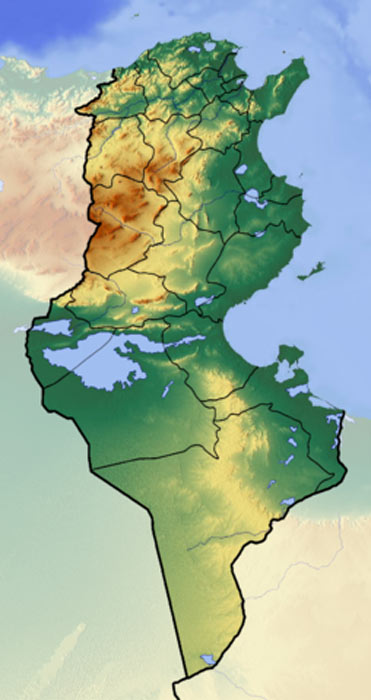
Tunisia’s largest salt lake, Chott el Djerid, in the middle of the country, just inland from the Mediterranean, is said to be the most promising location for the Tunisian Atlantis. (Dr Brains / GFDL 1.3 )
A Tunisian Atlantis Isn’t a New Theory At All!
In the years prior to the outbreak of the Second World War, and even in decades that followed it, there was a great interest in a Tunisian Atlantis. Many scholars and archaeologists proposed it as the possible location of the mythical Atlantis . Of course, over the millennia and centuries, Tunisia was home to some of Europe’s most advanced civilizations and cultures and was well known as a region to both the ancient Greeks and ancient Egyptians. And the Greek philosopher Plato (420s-348/347 BC) mentioned a specific location in ancient Tunisia in his quest to solve the Atlantis mystery 2,400 years ago!
Archaeological excavations yielded evidence that Tunisia was inhabited by humans as early as 100,000 years before present. Such evidence was discovered mostly in southern Tunisia, in particular at a site near the city of Tozeur, in the vicinity of some of the nation’s many chotts.
And it is these chotts that will be crucial in the story of the Tunisian Atlantis. But what are chotts? In simplest terms, a chott is an endorheic salt lake . Endorheic roughly means that it is stagnant water, not flowing out to any other body of water. In Tunisia, these chotts mostly dried up during the hot summer months, and fill up with water when it was cooler, and the tiny little springs began flowing into them again.
As salt lakes, they are a great source of crude salt for the inhabitants of the region, and can even be traversed during summer, when a salty crust is formed over the muddy dredges where the lake was. In the story of the Tunisian Atlantis, one such chott plays an important role: the Chott el Djerid.
Chott el Djerid, known in Arabic as Šoṭṭ el-Jarīd, is situated in the center of Tunisia about 124 miles (200 kilometers) west of the Mediterranean coast where the town of Gabès is located. Translated into English, Chott el Djerid means “Lagoon of the Land of the Palms,” and it is exactly this that could stand for the first piece of evidence.
Could that name be a hint to some ancient lagoon or oasis that stood on the site? Either way, this chott is the largest salt pan in the country, measuring some 2,700 square miles (7,000 square kilometers) in area. Its unique dry landscape is iconic and was used as the filming location for Tatooine, home to Anakin and Luke Skywalker and hideaway for Obi-Wan Kenobi in the Star Wars movie series. But could this chott be hiding more secrets? Several researchers think this huge salt lake so close to the Mediterranean holds the secrets of the Tunisian Atlantis.
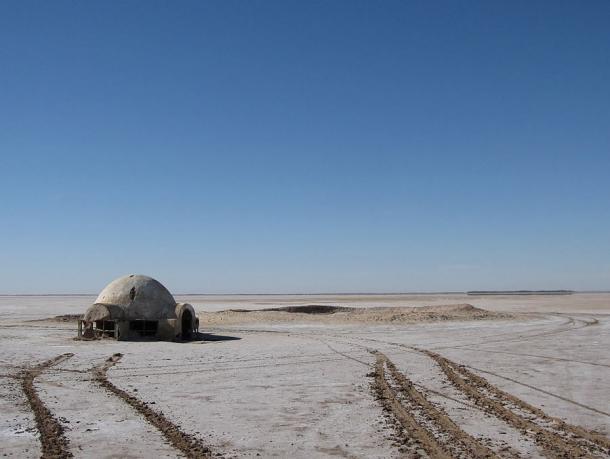
Tunisia’s Chott el Djerid salt lake as the shooting location for Tatooine, home to both Skywalker and hideaway for Obi-Wan Kenobi in the Star Wars movie series. (Stefan Krasowski / CC BY 2.0 )
Paul Borchardt, Ancient Greeks, and the Hunt for Atlantis
It was in the 1920s that a scholar named Albert Herrmann proposed that Chott el Djerid is the site of the fabled Atlantis. He connected the salt lake with Lake Tritonis , which was specifically mentioned by Plato in his work centered on the lost city of Atlantis.
Lake Tritonis (Greek: Τριτωνίδα λίμνην ) was described as a large body of fresh water located somewhere in North Africa, and was mentioned in several ancient texts, mostly in Classical Greece. What is more, ancient Greek writers all placed that lake somewhere in modern-day south Tunisia.
Herodotus tells us that the lake had two islands, one of which was colonized by the ancient Greek Lacedaemonians. Furthermore, several ancient legends cite this lake as the place where the Goddess Athena was born. It is also known that this lake had specially erected earthen dykes surrounding it, designed to stop it from drying up. However, an ancient natural disaster collapsed these dykes, thus sealing the fate of the lake and anyone who might have dwelt in it. Just like Chott el Djerid , and just like the story of Atlantis. Is this more than a coincidence?
Another scholar from the 1920’s thought so: Doctor Paul Borchardt. Borchardt was a colorful “jack of all trades.” Although coming from a family of German Jews, Paul Borchardt quickly adopted Theosophy and immersed himself in the occult works of Mrs. Blavatsky.
In his youth, he served with the German Army in the First World War , coming to prominence through his service in North Africa as a spy and a pilot. There, he became fascinated with Tunisia. He returned to explore the country after the war. It was during this time that he became convinced that Tunisia is the undeniable location of ancient Atlantis.
Borchardt stated that the lost city might have stood somewhere between the dried-up Lake Tritonis, i.e., Chott el Djarid, and the modern city of Gabès on the Tunisian coast. Gabès has very ancient roots and was known to the Ancient Greeks. It lies at the mouth of the Gulf of Gabès and opens up directly to the vast Mediterranean Sea before it. For many, this seems like the ideal spot for a powerful ancient city and perhaps the Tunisian Atlantis.
During his research, Borchardt recorded the name for the nearby site as Chott Hammeina, another dried salt lake that was perhaps an extension of the much larger Chott el Djarid. Paul Borchardt deduced that this lake was once called Lake of the Atlantes, formerly Lake Tritonis. Also, he recorded that the local name for Chott el Djarid was “Bahr Atala,” meaning “the Sea of Atlas.” This, and several other discoveries, convinced Borchardt that he discovered ancient Atlantis making it the Tunisian Atlantis.
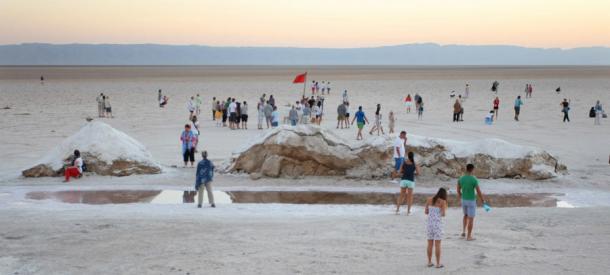
Tunisia’s Chott el Djerid salt lake is a big tourist attraction today but beneath these very sands may lie the ruins the Tunisian Atlantis! ( Goran Jakus / Adobe Stock)
The Enigma of the Dried-up Salt Lakes of Tunisia
Borchardt was at the head of a series of large excavations in the vicinity of modern Gabès, which yielded some interesting finds. He found the ruins of an ancient city (which could or could not be the remnants of the ancient city of Tacapae, as Gabès was called), remnants of a large irrigation canal, and enormous concentric features.
He also believed that the fabled Pillars of Hercules that were said to have stood at the entrance to Atlantis were actually found at the proposed temple of Hercules that was to be found at the entrance to the dried-up chotts. Furthermore, Dr. Paul Borchardt discovered numerous linguistic connections, chiefly the similarities between Berber tribal names and the names of the fabled Kings of Atlantis. For example, Plato stated that the founder of the royal house of Atlantis was King Euenor, a name which Borchardt connected to the name of Uenur, the mythical father of all Berbers. Yet another striking coincidence or . . .?
Borchardt’s highly elaborate theories were published in the 1920’s in several German science magazines. Notably, a very detailed map proposing the site of Tunisian Atlantis was published in “ Petermann’s Geographische Mitteilungen” in 1927. However, his work related to Atlantis ceased after the 1930s.
Borchardt was caught up in the whirlwind of World War Two, imprisoned at Dachau, and later sent to the United States through an intervention. He had connections amongst the Germans and was also known to the British MI5. In the USA, he was recruited as a spy for the Germans through an odd turn of events and denounced his Jewish background in favor of Catholicism. Alas, when the German spy ring in America was broken up around 1942, Borchardt was caught and sentenced to 20 years in prison for espionage. He was later granted early release and given a pension. Whether he ever returned to the matter of the Tunisian Atlantis remains unknown.
Today, these dried up chotts can be studied in greater detail, and they show a striking glimpse into the geography of Tunisia in the past. A glimpse that tells us that the whole area could have been one great inland sea in ancient times. The great number of these chotts, and their size, could mean that they were all once connected as a great sea. This was proposed as early as 1883, by Edward Dumergue in his booklet “ The Chotts of Tunis,” in which he states that:
“these chotts could be formed into one great inland sea, extending from near Biskra and Chegga in Algeria, through Tunis (Tunisia), to the Gulf of Gabès, about 300 miles in length and about 60 in breadth, forming a new gulf into the Mediterranean, with an area somewhat greater than the Irish Sea.”
Another French geographer from the 1880’s, Étienne-Félix Berlioux, proposed the very same theory.
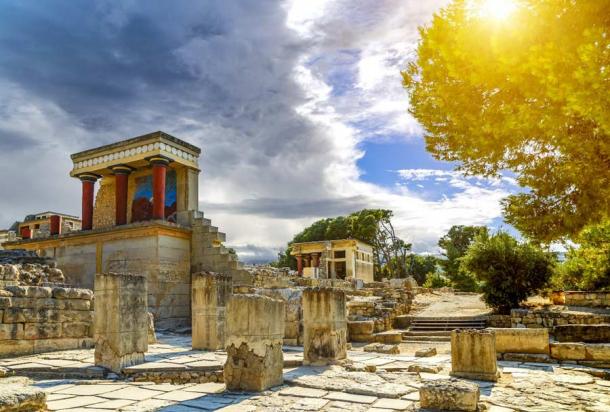
The 1200-BC mega-earthquakes in the Mediterranean mark the beginning of the Late Bronze Age Collapse that spelled the end of Knossos pictured here and Mycenae and Troy and probably also Atlantis. ( vladimircaribb / Adobe Stock)
A Totally Different Ancient Topography
Could this mean that the ancient city of Atlantis was once situated at the head of a deep and protected gulf that opened up onto the Mediterranean?
It is important to mention that ancient natural disasters could have greatly impacted the topography and geography of this area. Ancient Greek historian Diodorus Siculus tells us that a catastrophic seismic event or earthquake struck North Africa around 1250 BC. This could be the same devastating earthquakes that contributed to the collapse of the Bronze Age around 1200 BC, when civilizations and cities such as Mycenae, Knossos, and Troy dwindled and collapsed in just 50 years. Could it be that ancient Atlantis also suffered the same fate around this time?
Some scholars propose that these devastating natural disasters were responsible for changing the topography of Tunisia and cutting the great gulf off from the rest of the Mediterranean, eventually creating the numerous salt lakes that are now chotts. In fact, the central Mediterranean is known for its geological instability, making this theory quite reasonable.
In recent times, other scholars also stand firmly by the theory that Tunisia, and more precisely Chott el Djarid, is the site of ancient Atlantis. Italian professor Alberto Arecchi is one of the modern proponents of this Tunisian Atlantis theory. He states that the ancient inland sea in Tunisia was to the Ancient Greeks known as the “Atlantic Sea” or “Atlantic Ocean” (mentioned by Plato), and also agrees that the devastating seismic activity caused Tunisia’s giant inland sea to drain into the Mediterranean and effectively disappear.
In 2018, Charles A. Rogers also stood by the theory, identifying modern Tunisia as ancient Atlantis, whose capital city stood at the mouth of the “Triton River” that flowed into Lake Tritonis. Through careful deduction of Plato’s reckoning of years, Rogers concluded that Atlantis likely disappeared around the middle second millennium BC, just like the other civilizations that mysteriously collapsed in the region in the Bronze Age.
And this year, 2021, Hong-Quan Zhang of the University of Tulsa came forward with an evidence-based theory that places Atlantis at the eastern end of Chott el Djarid.
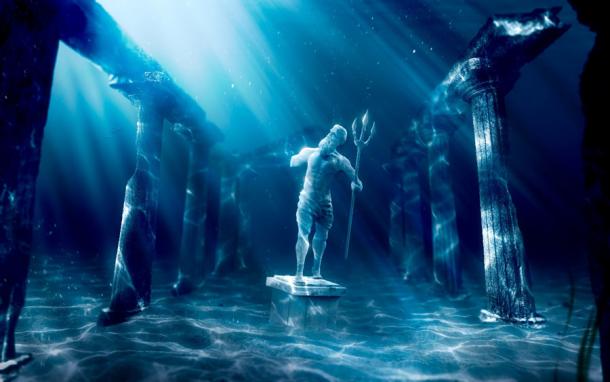
Related Post
A shocking documentary proves that mermaids do exist
SHOCKING Revelation: Thuya, Mother of Queen Tiye, Was the Grandmother of Akhenaten and Tutankhamun—What Ancient Egyptian Secrets Did She Leave Behind?
Breaking News: Astonishing Discoveries at Karahan Tepe Confirm an Extraterrestrial Civilization is Hiding on Earth, and NO ONE Knows!
Breaking News: Researchers FINALLY Discover U.S. Navy Flight 19 After 75 Years Lost in the Bermuda Triangle!
NASA’s Secret Investigation: Uncovering the Astonishing Mystery of the UFO Crash on the Mountain!
Explosive UFO Docs LEAKED: Startling Proof That Aliens Ruled Ancient Egypt!
